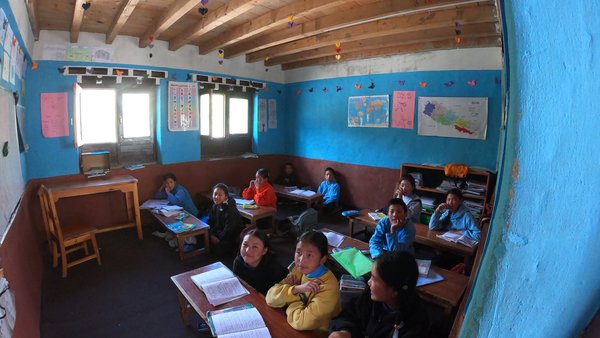Mr. Ananta Raj Acharya, the principal of Gyanodaya Madhyamik Vidhyalaya in Lete, Mustang, is an accomplished educationist. In his 22 year long tenure at the same school, he has had many success stories under his belt.
He managed to replace an old school building with a new grand building that was constructed with the help of the Indian Embassy. Recently, he was elated to see how his teachers were successfully integrating ICT in daily classroom teaching-learning practice. Mr. Acharya is determined to make the ICT integrated classroom a model for the whole district of Mustang.
Mr. Acharya’s dream does not seem too farfetched when he has dedicated and competent teachers like Mr. Sambhu Prasad Bhat. Observing Mr. Bhat’s ICT-integrated class is as good as getting a crash course on how to use various resources to deliver an effective class. Mr. Bhat has clear and well-thoughtout plan. He would start with Grade 6 English textbook where children are explained about alphabetical order. While the children eagerly read what the book has on the topic, Mr. Bhat writes the names of few students on the white board. He asks the children to arrange the names in the Alphabetical Order. Children are excited to see their names on the board. It did not take long for the children to copy the ten names in alphabetical order on each of their exercise books. The children are then asked to open their E-Paati laptops.

Excitement fills the room as they find an E-Paath activity titled ‘Alphabetical Order’. Children finish arranging the words in the exercise section of E-Paath with ease and they put on a wide grin when they get it all correct. Mr. Bhat ends his lesson with an announcement, “We will learn how to use a dictionary tomorrow. Alphabetical order serves as the basis of how you look for words in a dictionary.”
Visiting schools that have implemented OLE Nepal and Dept of Education’s joint OLPC program in Mustang, one gets an impression that keeping children happy in the classroom is critical to effective and in-depth learning experience. The moment children are asked to open their E-Paati laptops, the classroom beams with happiness. Children patiently wait for the teacher’s instructions and they go to the E-Paath lesson as directed by their teacher. This immediately opens the possibilities of self-learning . Children read, listen and work according to the instructions given in the E-Paath lessons. While playing with the E-Paath activities , children are learning new things as outlined in in the national curriculum for their grade. In Mustang, E-Paatis are serving not only as a teaching-learning tool but also as a source motivation for the children.
The same is true for children in the district of Makwanpur. Shree Devi School in the heart of Hetauda has implemented OLPC program with pride. Teachers in the school have found E-Paath lessons helpful in many ways. They say that E-Paath has created a paradigm shift from a teacher-controlled classroom to a teacher-facilitated classroom. One teacher opines that E-Paath has enabled him to pay more attention to slower learners in his class.
Visitors at the school can witness children’s immense affinity towards their E-Paath laptops. They frequently ran after the teachers requesting for permission to take their E-Paati home with them. When inquired why they wanted to take the E-Paati home, the surprising answer was “to read a story that I have downloaded from the E-Pustakalaya[1].”
E-Pustakalaya seemed to be making a big difference in enhancing pupil’s reading habits at the schools. E-Pustakalaya is no less popular amongst Dadheldura’s three program schools as well. Janaki Joshi, a teacher at Jana Joyti School at Hamtad, Dadheldura says “I am surprised at the rate at which children are reading books.”
The ICT-integrated teaching-learning in the classrooms of Dadheldura schools is proving to be a big boon for the mostly barefoot school children. The love for the E-Paati laptops and the educational content is so great that the classes fill with excitement when children are asked to read, listen and play o E-Paath activities. One of the officials of the District Education Office in Dadheldura was pleasantly surprised how effective learning was taking place in the classrooms. “Had it not been for the OLPC program, these children would have had to wait another 10 or 15 years just to touch a computer” said Mahadev Prasad Joshi, School Supervisor of Dadheldura District Education Office. “They now have not just the computer but also something to enjoy, read and learn”, added Mr. Joshi.
Integration of ICT in classroom activities is providing children with greater freedom in their learning. Pupils have been masters of their own learning and teachers’ role has been changed to guiding children to learn the underlying meanings of what they see or read on the screen. The new found change has been pleasant for both the stakeholders. Parents are no less happy to see their children spending time reading contents on the screen. One of the parents, Tek Bahadur Dhami, of Jana Joyti said:
“Initially I thought that my son was wasting time reading something trivial for too long on the computer. When he began reading me the stories and rewriting the stories that he read, I realized that he was not wasting his time.”
The disparity in accessibility of educational resources amongst the of haves and the have-nots is unimaginably wide in Nepal. OLE Nepal and Department of Education’s joint OLPC program may seem like just a drop in the ocean to fill the divide, but it certainly is setting the precedence in successful integration of ICT and could be the answer to meeting the challenges of effective teaching and learning in the remote areas of the country.